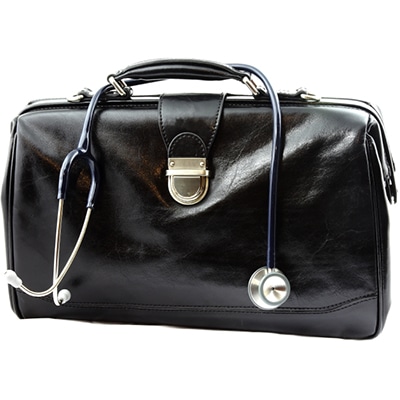 Doctors Bags
Doctors Bags
Doctor’s bags are important when carrying out home visits and the contents can vary between doctors and the work they undertake. Although some doctors may not have very much in their bags when going on home visits depending the location of the practice because the drugs required by a remote and rural GP can be very different to drugs required by an inner city GP. However the choice of what to include may be determined by the medical condition they are likely to face, the medicines they are able to use, the availability of emergency services if required, and where the local pharmacy is and if it would be open at that time.
Things to consider
When a doctor decides to take medication for a home visit they must be aware of the temperature since most medicines should be stored between 4° and 25°C. When working away from the practice the doctor must still be mindful of health and safety and infection control, they should have gloves and alcohol gel available. If they are taking equipment with them, such as an electronic BP machine they must remember that it requires portable appliance testing. Doctors may need reminding to have it available for testing each year, since they sometimes get forgotten about because they’re out of sight. They should remember to keep the bag locked when not in use and never leave it unattended.
Stock and Expiry dates
Because medication in doctors bags is out of sight it can get forgotten about so it’s important to treat it in the same way as other medication in the practice. Regular checks of stock levels and expiry dates should occur and a system should in place to immediately replace medication and items that have been used. A separate Controlled Drug (CD) register should be kept if CD’s are to be kept in a doctor’s bag.
Changes to Mythbusters
Prof Nigel Sparrow, CQC’s Senior National GP Advisor clears up common myths about inspections of GP services and shares agreed guidance to best practice. Nigel’s surgery: Tips and mythbusters for GP practices has been given a makeover this year and the mythbusters are now listed under the five key questions that the CQC asks about services during inspections. You can find his mythbuster about emergency drugs for GP practices in the link below. There is also a link to another really helpful article which contains a list of suggested drugs, based on guidance from the Drugs and Therapeutics Bulletin.
Links
Nigel’s surgery 9: Emergency drugs for GP practices:
http://www.cqc.org.uk/content/nigels-surgery-9-emergency-drugs-gp-practices
Patient Info:




